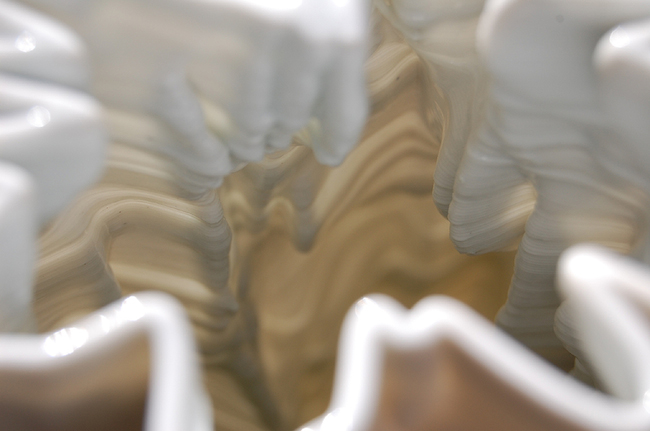We gave techy Suffolk artist Jonathan Keep a mention in this issue; his 3D printer design was used in a different clay project by Jenny Filipetti (read more about that here). We wanted to direct your attention to an earlier project by Keep that also utilizes 3D printing in clay. His Icebergs series showed as part of an exhibition at Puls Ceramics, Brussels in 2014.
Above image: Jonathan Keep, from the Icebergs series (detail), 2014. Photograph courtesy of the artist.
From the artist:
Jonathan keep’s ceramics have always been recognisable for a strong sculptural quality with an emphasis on form. An opportunity fourteen years ago to investigate digital media highlighted for him the possibilities of using computers to extend and explore his understanding of natural forms, systems, patterns and codes.


Jonathan Keep, from the Icebergs series, 2014. Photographs courtesy of the artist.
Jonathan has developed a working process whereby the shapes of his pots are written in computer code. This digital information is then processed and sent to a studio based self built 3D printer that he has designed specifically to print in clay. Layer by layer the pots are printed out – a sort of mechanical pottery coil building. After printing the ceramic is fired and glaze in the normal way. In the elemental forces of earth, fire and water ceramics has traditionally drawn on nature for inspiration, but in using computer code to create his works Keep has added a further layer to include the elemental mathematical patterns and structures that underlie all form. The appreciation of these works he hopes illustrates just how much we are connected at a very deep level to the natural world.
“Nature – not objective nature out there but subjective, universal nature within us all, maker and viewer is what my work is about. How the patterns and systems that make up observable nature are the same processes that determine our biological and cultural personalities. So the material and process of making becomes integral to the content of my work.”
Jonathan Keep writes:
On the premise that the technique used to create form influences the form itself I have made extensive use of the computer to evolve ideas. I do not use the computer as a design device but as a piece of new technology, as a tool that will generate forms not typically visualised or created by other ceramic techniques.

Jonathan Keep, from the Icebergs series, 2014. Photograph courtesy of the artist.
This working method I have now developed to a point where I am using the computer code to explore shapes and generate three dimensional objects. Stimulated by my interest in natural systems, patterns and the unseen numerical code that underpins all nature this offers a very new way of working. Being able to work with the material of digital computation, in the form of java computer language I am able to grown my forms in virtual space. 3D printing enables me to get the information out of the computer and made directly in clay, offering a physical object that can be held in the hand in a very short time span.

Jonathan Keep, from the Icebergs series, 2014. Photograph courtesy of Puls Ceramics.
I tend to work in series based around an idea or creating morphologies of related works. I am interested in the sense of time that this offers, a sort of animation captured over time. Referencing growth patterns, erosion patterns or mimicking evolutionary processes at the level of code I can gradually alter parameters and numerical values to create groupings of vessels. The Iceberg series is concerned with exploring the beauty of these apparently random natural forms. The algorithm used to generate these forms has an inbuilt randomness set within natural parameters as with the formation of icebergs or stalactites and ant hills. These structures have an underling logic that computer code can mimic so a different and original object is created each time the code is run. The cumulative layers of the 3D printer forms recall the glacial strata of icebergs, and offer a sense of timelessness. The choice to use pure white porcelain is then deliberate so as to echoes the translucency of ice – the process, material and content of the work are one.

Jonathan Keep, from the Icebergs series, 2014. Photograph courtesy of the artist.
While 3D printing is not new it is the availability of the equipment to sit in the ceramic studio next to the pottery wheel that is new and offers a very exciting way of working. The 3D printer becomes a tool that enables me to make the objects that have been conceived within the computer. Like all tools, like the pottery wheel, it is how the artist uses their equipment that is of importance and I seek to engage with the process and to manipulate it towards my own ends to craft the objects I am looking for.
We also appreciate Keep’s “open source” approach to technology and art. He has a handy page on his web site that teaches people how to build their own 3D printer for ceramics.
Any thoughts about this post? Share yours in the comment box below.

Jonathan Keep’s 3D printer. Photograph courtesy of the artist.

Add your valued opinion to this post.